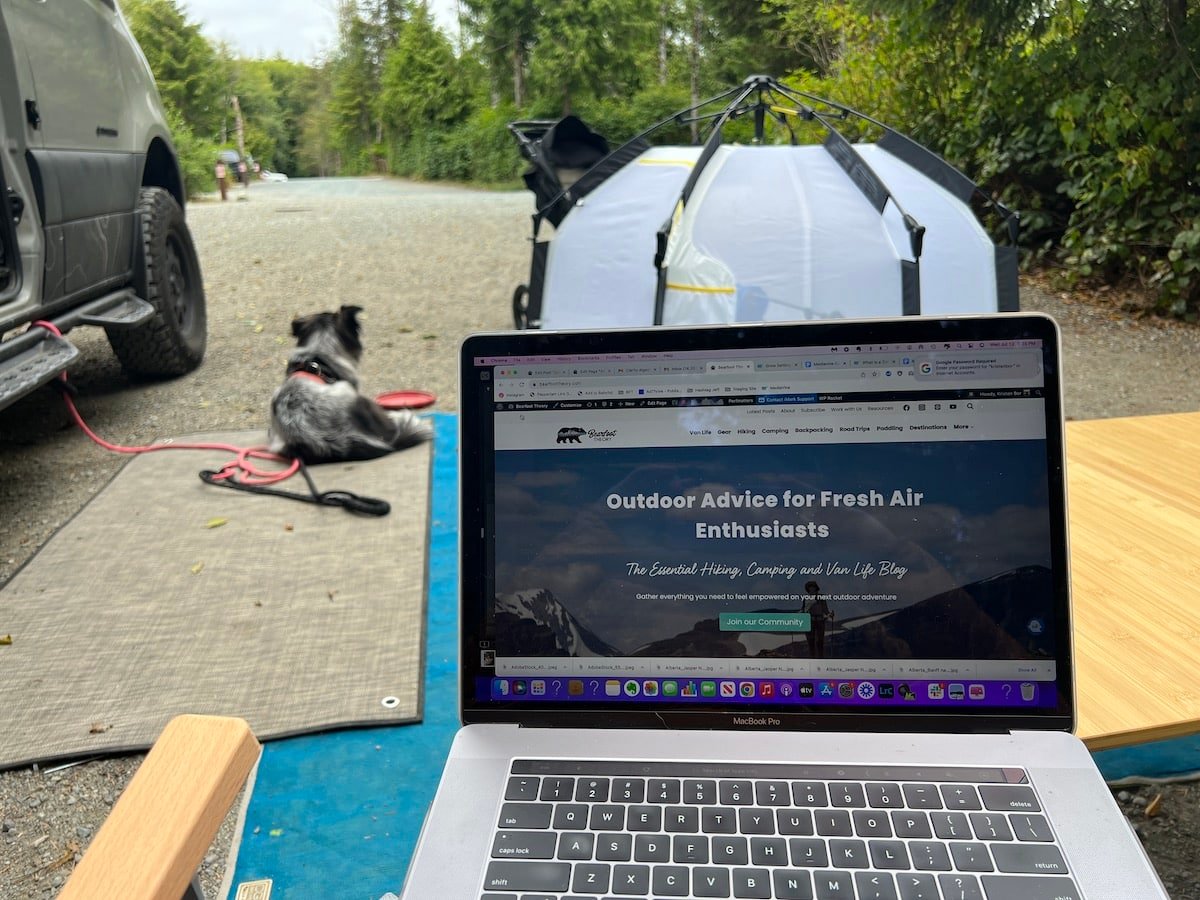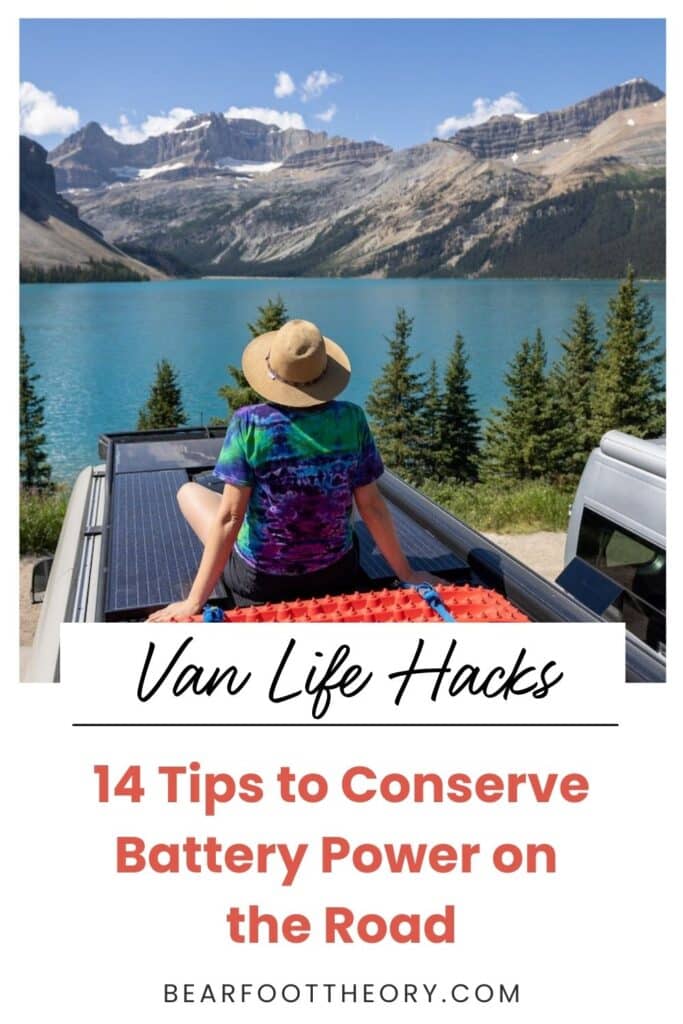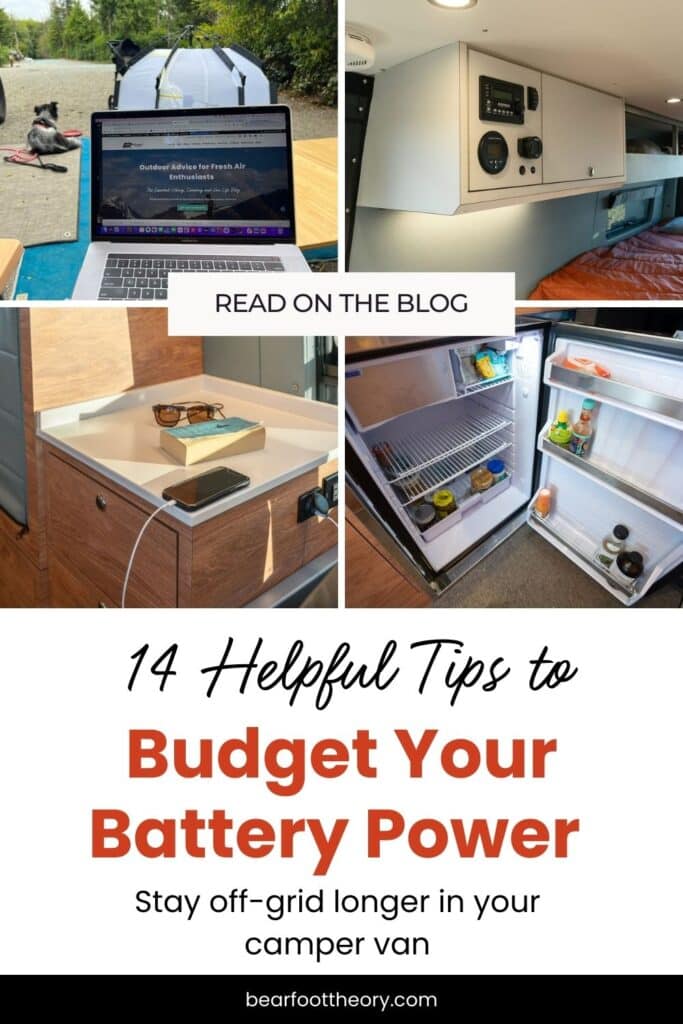Whether you live on the road full-time or part-time, there will likely come a day when you need to conserve battery power in your camper van. This may be because you’re camping off-grid on dispersed land for days at a time, or perhaps you’re staying in a campground or going to a festival that doesn’t offer electrical hookups to plug into shore power.
In my first Sprinter van, I learned about the importance of conserving my battery power the hard way after completely depleting my batteries while traveling on the Olympic Peninsula. I’ll preface this with the fact that it wasn’t all my fault. My van had some wiring issues and my solar panels weren’t charging the batteries properly, and I also didn’t receive any sort of training from my van builder on how to monitor my system.
Either way, I used too much power and my batteries went dead. I realized my problem when my freezer starter defrosting and melting ice water leaked out of my fridge all over my van. Not only did nothing in my van work, but drawing my batteries down so low caused irreparable damage, and the batteries had to be replaced.
This was a tough and expensive lesson during my first few weeks of van life and after that, I constantly stressed about making sure I didn’t make the same mistake again.
My battery bank wasn’t all that big, and I also didn’t have enough solar on the roof to ever be carefree about my power consumption. Winter was particularly challenging with less sun and the need to run my heater. During this time, I had to be very careful to not deplete my batteries and learned some helpful tricks for conserving my power.
Now that I have lithium batteries (the Lithionics system) in my current Sprinter van, I don’t have to worry about running out of power anymore. On a 5 week trip, my batteries never dropped below 75% capacity!
Although it’s not as big of a concern for me now, I still remember what it’s like to be worried about running out of battery power while camping off-grid. I know that power consumption is a common concern for new van lifers, so in this post, you’ll find some helpful tips I’ve learned over the years for conserving battery power in your camper van so you can stay off-grid longer.
1. Track your battery usage
Before you can begin to conserve battery power in your camper van, you have to consider how you’re using your battery currently. Which devices or appliances are you using that draw power, how often are you using them, and how much power do they draw?
Here are some common van life appliances that draw power:
- Airconditioning or fans
- Electric heaters
- Induction stove
- Refrigerator
- Oven or microwave
- Hairdryers
- Electronic devices that require charging like laptops, phones, cameras, etc.
Monitor how often you use these appliances and watch your battery meter to get an idea of how much battery power they use. From there, you’ll be able to quickly learn which devices are drawing the most power and if there are more efficient switches you can make (as discussed later in this article).

2. Invest in efficient van appliances
Some appliances are specifically designed to be energy efficient and consume less power than others. Although energy-efficient appliances may cost more upfront, they are worth it for the amount of power you can save.
As you browse for appliances, you can tell if an appliance is energy-efficient if it has the Energy Star label, which means it meets or exceeds U.S. Environmental Protection Agency (EPA) energy efficiency standards.
Most appliances in the U.S. come with an Energy Guide label on them to explain how much energy the item consumes in kilowatt-hours (kWh). You can compare appliances you’re considering to see which uses the least kWh.
I also recommend shopping for appliances that are equipped with energy-saving features. For example, you could look into a heater or air conditioning unit with programmable settings to turn off after a certain duration of time or once a specific set temperature is reached.
In my van, which was converted by Outside Van, we have the Webasto Air Top EVO 40 Heater, and I like how we can digitally set our desired temperature. Once that temperature is reached, the system idles, which helps us save power.
If there’s one energy-efficient appliance I recommend investing in, it’s the refrigerator for your van. Check out the tip below for how to choose an energy-efficient fridge.

3. Choose your fridge carefully
If you think about it, your fridge is the one appliance that’s always running 24/7 in your van. You might as well get one that’s not going to completely drain your battery.
Even though it may be tempting to pick the largest fridge possible for your van, smaller refrigerators tend to consume less energy than larger ones since there is less to keep cool. You also want to look for a refrigerator that has quality insulation and tight door seals so cold air doesn’t escape as easily.
The compressor of your fridge is crucial since it cools the interior. A fridge with a variable-speed or inverter-driven compressor adjusts its speed according to the cooling needs versus constantly running at the same speed.
Most energy-efficient fridges only draw 1-2 amp hours per hour. I have the Isotherm Cruise Elegance fridge which is super popular among van lifers. It is 4.6 cubic feet and has a Danfoss compressor with a low power draw.

I had to get a second fridge in my van last year to store frozen breastmilk. I used the National Luna, which is one of the most energy-efficient chest-style fridges for overlanders. I was surprised at how little power it drew. Other popular refrigerator brands for van life include Dometic, Norcold, and Nova Kool.

 ) after having a baby
) after having a baby4. Park in the sun to maximize solar charging
First and foremost, I highly recommend investing in solar panels for the roof of your van if you haven’t already. My first Sprinter van didn’t have enough solar, and I quickly learned that my battery situation would have been a lot less stressful if I had invested in higher-wattage panels.
With solar panels, you can use the sunlight to your advantage and charge your batteries during the day. Although it’s tempting to park in the shade on a hot day, I recommend finding a spot in the sun so your panels get the maximum amount of sunlight.
Another option is to invest in portable solar panels that you can prop up in the sun while your van is parked in the shade. Then you’ll get the best of both worlds!

Essential Tip
Clean your Solar Panels
Your solar panels will get dusty when you’re driving on dirt roads, and all that dust will reduce the power produced by your solar panels. Make sure you climb up there periodically to wipe them off with a wet rag. Don’t use any chemical cleaners without checking with your solar manufacturer first!
5. Use window coverings to insulate your van
Although you may not realize it, your van’s insulation indirectly affects how much battery power you use to either warm your van up or cool it down. Proper insulation can regulate the temperature of your van to keep things feeling comfortable inside. In my van, Outside Van used 3M Thinsulate – one of the most popular and effective materials for insulation. Wool is another insulating material chosen by van builders.
If you have poor insulation, you’ll likely need to run the heat or cooling appliances like air conditioning, fans, or a heater more often. This can drain your battery power.
In addition to the insulation behind your walls, window shades, covers, and curtains can all help insulate your van. In my living area, I use insulating window shades made of closed-cell foam to help prevent heat from entering in the summer and keep warm air from escaping in the winter.
I also have window coverings to put over the front, driver, and passenger windows. These are convenient for blocking out the heat from the morning sun. I also always put these up if I’m stepping out for a while to go on a hike or walk my dogs. These help regulate the temperature and keep heat from the cab from entering the back of the van.
Outside Van made my window coverings custom, but there are other companies that make window shades for various types of vans.

6. Save the AC for the hottest days
If you have a rooftop AC in your van, you’re likely tempted to turn on the air conditioner in your van on hot days. I know I would be if I had AC!
However, rooftop ACs are one of the quickest ways to drain your batteries, so you may want to consider if there are other ways you can improve the airflow. Otherwise, you may be taking a trip to the RV park so you can plug in!
Before you crank the AC, open your windows and turn on the fan to get some good cross-flow. This may be enough to reduce the temperature in your van so you don’t feel the need to use your AC.
In my van, I have two Maxxair fans in my Sprinter van: one above the galley and one above the bed. I usually have one of the fans programmed to pull fresh air into the van, while the other van pushes the stale air out. That along with some vented windows offers a pleasant breeze when we are sleeping at night.
Of course, if you plan to spend the summer in Florida or Arizona, a couple of fans and some cracked windows will not be sufficient. So you’ll want to make sure you have ample battery capacity as described at the end of this article.

7. Charge your electronics in public spaces
Although I usually work from my van, it’s sometimes fun to check out a coffee shop in a mountain town or work in a public library for a change of scenery. If I know I’m going to be spending time in a public space with electrical outlets, I always bring my devices and cords to charge my electronics.
You could bring your laptop, phone, camera, and any other electronics that you can easily transport. You can plug everything in and let it charge back up to 100% while you get some work done before heading back to the van.

8. Avoid Charging Devices Overnight
I recommend not overcharging your appliances by leaving them plugged in overnight. I’m guilty of plugging in my iPhone before I go to bed and letting it charge all night, even once it has gotten back up to 100%.
If you have a big battery bank, this won’t be a big deal, but if you’re really trying to conserve battery power in your camper van or are running low on power, every little bit you can save is important.
Keeping electronics plugged in overnight wastes unnecessary power. As soon as your device is fully charged, you should unplug both the device and the cord from the outlet to save the most battery possible.

9. Unplug devices when not in use
Even when your electronics are powered off, they still consume power if they’re plugged in. Every time you step away from your van or go to bed, you should unplug all of your devices and chargers so they don’t unnecessarily drain your battery.
This is especially true of power-hogs like Starlink. Don’t fall asleep watching Netflix and forget to unplug your Starlink before bed!
Another trick is to use a power strip for all of your electronics. A power strip allows you to plug in multiple appliances at once and turn them all on or off with a switch, making it a convenient way to turn everything off all at once.

10. Turn off your inverter when not in use
The inverter in your camper van powers your appliances. It draws power when it’s turned on, even when nothing is plugged in and it’s not being used.
Although the inverter itself only draws a little power, forgetting to turn it off overnight could result in you waking up to a noticeable loss of battery power. I forgot to kill my inverter before going to bed once and noticed my battery dropped about 5-10%.
Constantly running your inverter also adds to its wear and tear. By turning it off when you’re not using it, you can potentially increase the lifespan of your inverter and limit the risk of needing to repair or replace it sooner than necessary.

11. Charge things during the day and while you’re driving
If you’re using solar panels, you should charge your devices when the panels produce the most power, which is typically during the day when the sun is directly overhead around noon.
By charging your laptops and phones during the peak sunlight hours, you can prevent your batteries from draining overnight when there is no solar available.
If your van battery also charges off of your alternator, you can also prioritize charging for when you’re on the road. Once your battery hits 100% while you’re driving, you can charge the devices without using any additional power and still be at 100% battery life when you reach your campsite.
I’ve found that with my secondary alternator in my Sprinter van, I can add a ~10% charge for every 20 minutes of driving that I do. This means that with a little over 3 hours of driving, I can completely recharge my battery back to 100%.

12. Maximize natural light
The overhead lights on your van might draw more power than you think. Instead of reaching for the light switch, try to use as much natural light from the sun as possible during the day.
You can also invest in portable solar lights that charge during the day that you can use in your van at nighttime. When Bearfoot Theory contributor Kaylin’s light switch broke during her 2-month trip to the desert, she used these solar lights to see inside her van at night.

13. Develop power-savvy habits
Unlike a home where you might accidentally leave a light turned on all day, you should never do this in your van. If you’re leaving the van, turn off the lights and unplug everything before you go.
In order to conserve your camper van’s batteries, you could also take on some new power-free hobbies. Most likely a major reason you’re doing van life is to connect with nature, so instead of spending hours on your electronic devices, you can focus on getting outside and doing the activities you love.
There are also options for entertainment in your van that don’t require power such as books, cards, cooking, camping games, crafts, etc.

14. Replace items that draw power when feasible
A final tip for conserving battery power in your van is to look for alternative devices that don’t require power. Here are some ideas for simple switches you can make:

Invest in a High-Capacity Battery Bank
You can have all of the solar in the world, but if you don’t have anywhere to store it, parking in the sun won’t do you any good. Solar also can’t power your stuff at night or on cloudy days.
That’s why the size of your battery bank is the biggest determining factor in how long you can conserve battery power in your camper van and stay off-grid longer.
If you can afford a high-capacity battery, you can store more of your power for when you need it. I recommend upgrading from AGM batteries to lithium batteries (which is what I did for my current Sprinter van conversion).
Although lithium batteries are more expensive, I truly believe they’re worth the investment, especially if you live and work in your van full-time.
With AGM batteries, you can only use about half of the battery before you need to charge them; however, with lithium batteries, you can use 90%. This means you get a lot more usable power out of lithium batteries. Read this article to gain a better understanding how your solar and batteries work together and how to plan your power system in your van.
READ NEXT
Want more van life tips? Check out these other helpful articles:
Save this post to Pinterest
Do you live on the road? What tips would you add for conserving battery power in your camper van? Let me know in the comments!
The post 14 Tips for Conserving Battery Power in Your Camper Van appeared first on Bearfoot Theory.












